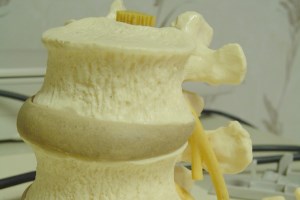Spinal Anatomy 101
 “Never grow a wishbone, daughter, where you backbone ought to be.”
“Never grow a wishbone, daughter, where you backbone ought to be.”
-Clementine Paddleford, American Writer (1898 – 1967)
It’s no accident that so many philosophers and writers have used the backbone as a metaphor for discipline, force of will or character. Your spine (or “backbone”) is the primary physical support for your body’s entire frame. It’s a remarkable piece of natural engineering composed of 33 separate vertebrae that act as a single unit to provide stability as well as flexibility while you’re sitting, standing or in motion. A healthy spine is both strong and resilient. With proper nutrition, exercise, postural habits and chiropractic care, it can allow us to lead an active lifestyle well into old age. However, poor biomechanics, injury and disease can cause problems with the spine that result in misalignment, inflammation, pain and restricted movement.
The spine develops from infancy into adulthood, gradually evolving from a C-shape, which is suitable for crawling, to its distinctive S-shape, which is the appropriate shape for two-legged walking. The natural curves in the spine serve to cushion impact from movement, absorb shock, preserve balance, and allow range of motion. The three main curves in the spine are known as the cervical curve (the neck region), the thoracic curve (the upper back) and the lumbar curve (the lower back).
There are 7 cervical vertebrae, 12 thoracic, 5 lumbar, 5 sacral and 4 coccygeal vertebrae. The sacral and coccygeal vertebrae are those located lowest in the spine, below the area of the lumbar curve. Twenty-four of the vertebrae in your spine are moveable. They are cushioned by intervertebral discs which act like coiled springs. These discs are fluid filled and—as we age—become thinner and more brittle, often causing us to get shorter. Over time (or as a result of excessive wear and tear or specific injury), they can degenerate, bulge or herniate, potentially causing significant pain and loss of mobility.
There are several other common spinal disorders. Lordosis, also known as “sway back,” occurs when there is abnormal forward curvature of the lumbar spine. Those who have abnormal curvature of the thoracic curve have kyphosis, or “hunchback.” Scoliosis occurs when there is a side-to-side curvature in the spine. Slight curves of less than 20 degrees do not usually present health or problems and are seldom treated. Moderate or severe curves usually require treatment because they can interfere with the functioning of internal organs and may significantly limit physical activity.
While the bones and connective tissues of the spine are very good at what they do, they cannot support the body’s weight and facilitate movement on their own. They need the help of strong core muscles. Good muscle tone is important to help maintain proper posture and spinal alignment. This is why it’s so important for us to put effort into maintaining proper posture when we sit, stand, lie, walk and run. Over time, poor posture can place unnatural stresses on the musculoskeletal system (especially the spine), limiting our range of motion and producing pain.
In addition to its role in supporting the body’s frame and facilitating movement, the spine has another important role as well. The spine’s bony vertebrae also encase and protect the spinal cord, which is connected directly to the brainstem. It’s hard to exaggerate how important this protection is. Damage to the spinal cord can cause numbness and loss of motor function. Injury to the cervical area can cause tetraplegia (also known as quadriplegia), while injury to the thoracic or lumbar area may result in paraplegia, or loss of the use of the legs and trunk.
This article serves as a brief introduction to just one aspect of your anatomy. If you are in the Billings area and need a Billings Chiropractor and you have any questions about your spinal health or your musculoskeletal health more generally, please don’t hesitate to call us at Oblander Chiropractic or visit our office (406-652-3553). We’re here to help!

